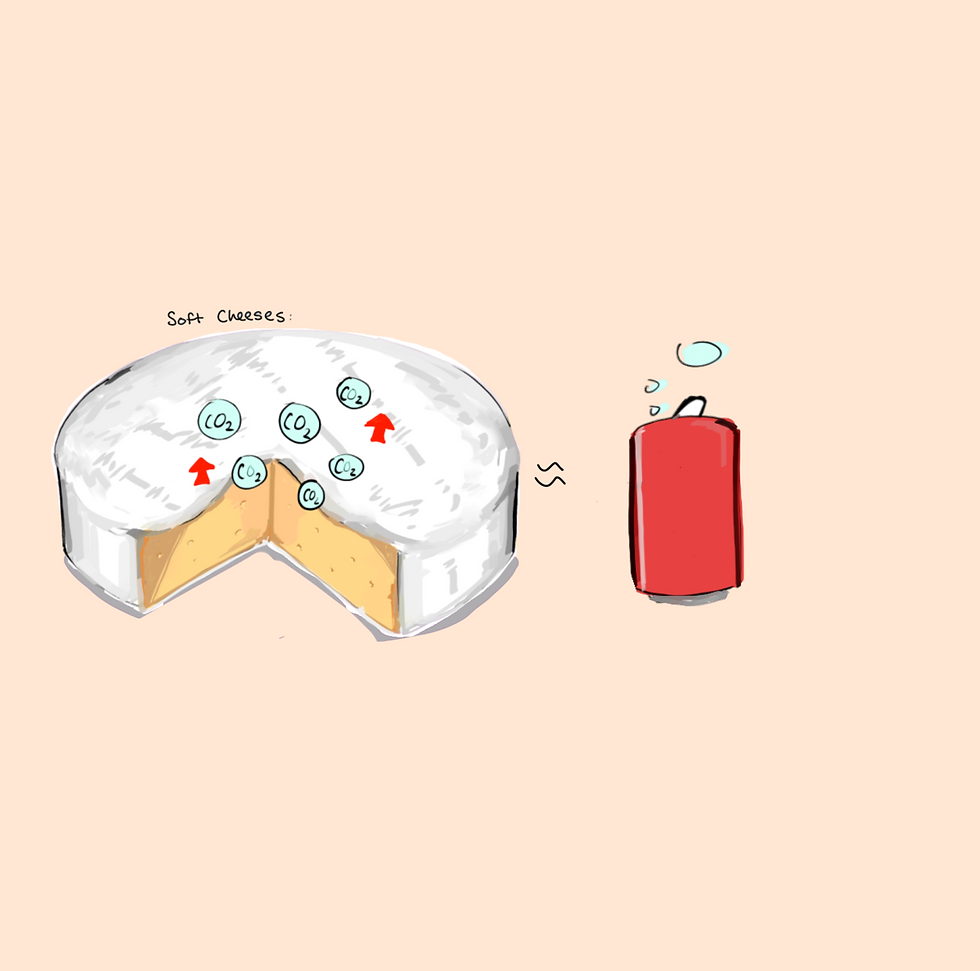The Biochemistry of Cheese
- Science Holic
- Sep 30
- 3 min read
Author: Simone Maimon
Editors: Hwi-On Lee, Serena Tsao, Kacey Ye
Artist: Caitland So
Cheese comes in many varieties, ranging from hard and soft cheeses, long-aged and short-aged cheeses, and those with a strong flavour to a mild aftertaste. But, despite the variety, ingredients that can be used to make cheese can be as simple as milk and a coagulant (such as vinegar or lemon juice, and Rennet). So, what exactly causes these transformations?

Behind every cheese is a variety of enzymes, whether they come from bacteria that feed off the cheese, or the milk itself. These enzymes play a critical role in transforming certain molecules present in the cheese, forming its unique flavor and texture. The three essential processes that contribute to this process are lactose and lactic acid metabolism, lipolysis, and proteinolysis.
Firstly, lactose and lactic acid metabolism mainly contribute to the characteristic structure of cheese, consisting of holes and—in the case of Camembert cheese—hard shells coating a soft interior. Lactose, a sugar in milk notorious for being hard to digest, is broken down into lactic acid by lactic acid bacteria. The lactic acid is then metabolized by Pr. freudenreichii into propionate, acetate, carbon dioxide, and water. In softer cheeses, the carbon dioxide bubbles form air bubbles within the cheese, much like the process of carbonation in seltzer drinks. On the other hand, in hard cheeses, the carbon dioxide migrates and accumulates in holes that have already formed, creating huge air pockets. The propionate and acetate slightly contribute to the flavor, known to taste slightly ‘fruity’ or ‘banana-like’.
Lactic acid metabolism contributes to a hard outer layer in some cheeses by changing the acidity. As P. camemberti accumulates on the outside of the cheese, it creates NH3. Because this molecule is basic, it increases the pH of the outside of the cheese. This causes calcium phosphate to form around the edges of the cheese, giving cheeses like Camembert a hard outer coating while retaining a gooey, soft inside.

Secondly, milk, rennet, and various bacteria contribute to lipolysis, or the breakdown of fat molecules, contributing to the characteristic cheese flavor. Lipolysis converts triglycerides, which are three fatty acid molecules covalently bonded to glycerol, into the constituent molecules. This process is also essential to the ripening of cheddar, gouda, and swiss. When fatty acids undergo a reaction with ethyl alcohol, this produces an ethyl ester. Alternatively, thioesters are produced when compounds with a thiol group (sulf-hydryl) are used in place of ethanol. Esters usually smell sweet and fruity, but the sulfur atoms in the thiolesters bring a rancid smell, which is partially why excess lipolysis can lead to rancidity. Another type of compound, lactones, is produced by fatty acid oxidation, known to have a milky and coconut flavor.
Lastly, when a cheese ages, it goes through proteolysis, the breakdown of proteins. Casein is the main protein that forms the curds in the milk and allows the cheese to hold its shape. The cheese becomes softer when this protein is broken down by residual chymosin from the milk. The amino acids, which are produced by proteolysis, can then be metabolized into compounds. These compounds, alongside lipidolysis, create a unique cheesy and slightly bitter flavor. These amino acids contribute to the flavor of cheddar.

Overall, the intricate, bitter, sweet, cheesy, and milky flavors of cheese are heavily intertwined with the biochemical processes that occur during fermentation. The vast variety of textures also stems from the reactions that take place as a cheese matures. Even though the ingredients of cheese are relatively simple, it is the reactions which take place over time that differentiate each cheese from the rest.
Citations:
Marella, E. R., Dahlin, J., Dam, M. I., Ter Horst, J., Christensen, H. B., Sudarsan, S., Wang, G.,
Holkenbrink, C., & Borodina, I. (2020). A single-host fermentation process for the production of flavor lactones from non-hydroxylated fatty acids. Metabolic engineering, 61, 427–436.
P.L.H. McSweeney, Biochemistry of Cheese Ripening: Introduction and Overview, Cheese:
Chemistry, Physics and Microbiology, Academic Press, Volume 1, 2004, Pages 347-360, ISSN
1874-558X, ISBN 9780122636523, https://doi.org/10.1016/S1874-558X(04)80073-3.



Comments